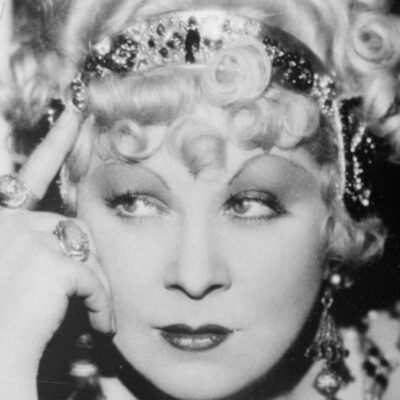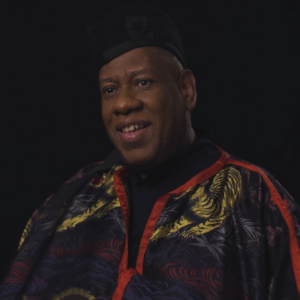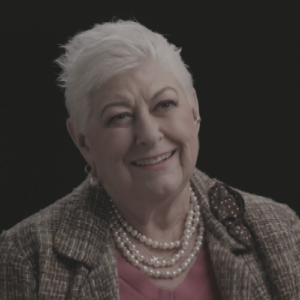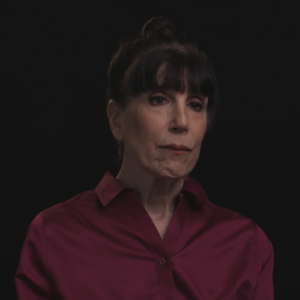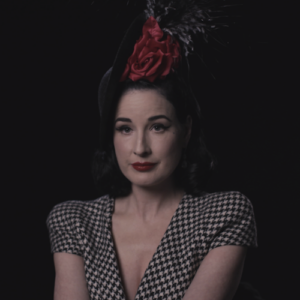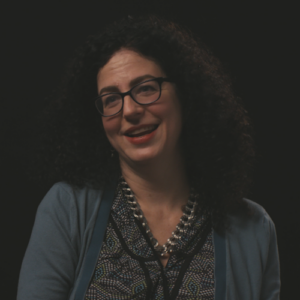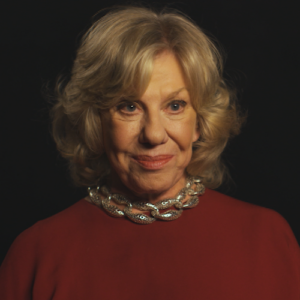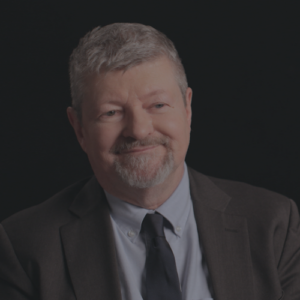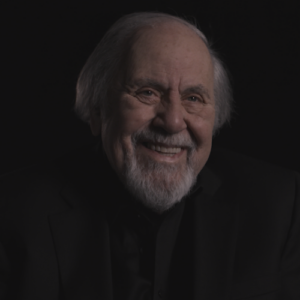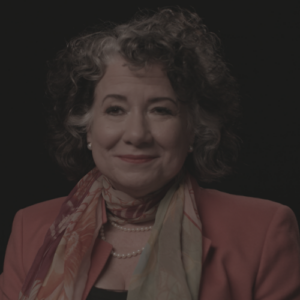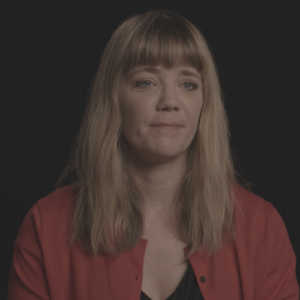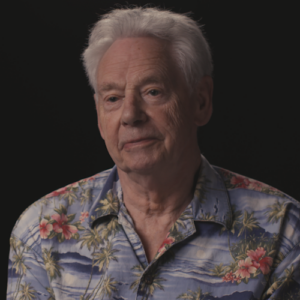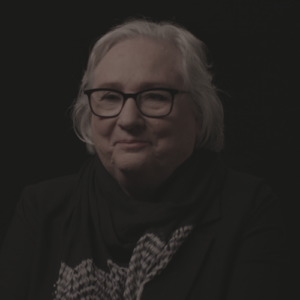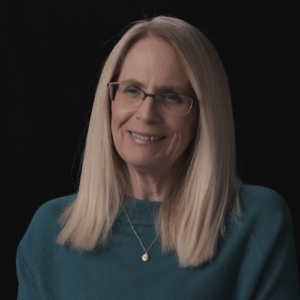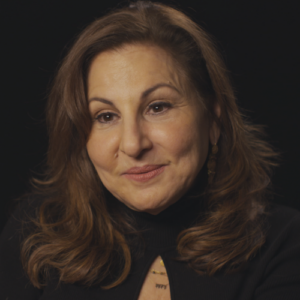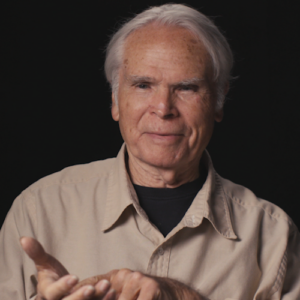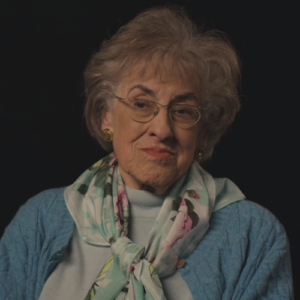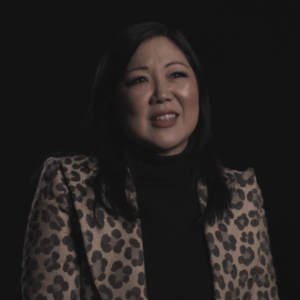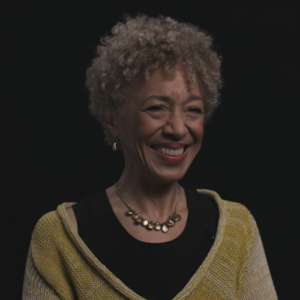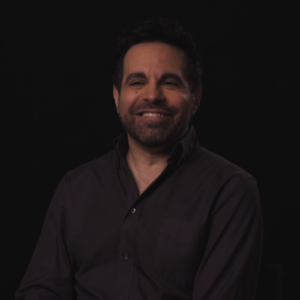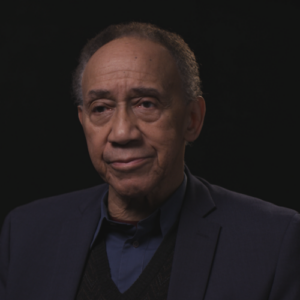Interviewer: How were you first introduced to Mae West, do you remember?
Lady Bunny: I watched old movies as a child. Back when there were like four channels. And so Mae was on heavy rotation, and I was always inspired with my look, you know, by her. You can’t really tell it because I think I read more as Wallace Beery. And now there’s some there were maybe Fatty Arbuckle after the winter hibernation, but I was always drawn to me. I didn’t realize it until much later, but she ran the show and here she was in these glamorous, ultra glamorous, you know, sometimes ridiculously glamorous costumes with the picture hat, with the full length gown beaded. And, you know, also another thing that I kind of do like her, not exactly, but she would often wear a gown that was black slimming with white down the front of it. So you see the white line and you don’t think of anything else that might be going on. Now. I may have incorporated that into my beaded kazee thanks me. But yeah, she she was draggy because she did such a look she wasn’t wearing separates this step was custom made you know and it was giant picture hats, boas you know, lots of high contrast black and white. She loved that because it does make you jump out in any shot. Oh, no. So it you know, she definitely had her own thing and just hearing that crazy. Oh, wow. You know, I mean, if you know what that is, it just transports you into her world all over again. I mean, later on, I would learn that she was a friend to drag queens and prostitutes and didn’t do her first film until age 40. There’s hope if I go back ten years and she, you know, was famous for her stage plays, which did include drag queens and sorry, which did include drag queens and prostitutes and was like a, you know, fighter for them when that was very, you know, disapproved of back in the 1920s. So, you know, that kind of cemented my bond with her. And then if, you know, this was pre-prohibition, wasn’t it? So, you know, it was definitely naughty. And she definitely was a sexual creature. She was never an on she knew she knew in her, you know, more male driven world back then that she had to use what she got to get what she wanted and she did it, you know so very well that she was a trickster who could play men off of one another and always end up winning and in luxurious furs and costumes. And sometimes you were treated to a musical number where she talks, sang, and there’s nothing more camp than her rock and roll albums. When you hadn’t heard of Nay in a couple of decades and suddenly swinging his back out with hits of the Beatles or, you know, I mean, and The Voice, you know, I mean, it didn’t have a lot of range, but it was unmistakable.
Interviewer: Well, how do you define camp? We keep hearing very different ideas, but this.
Lady Bunny: Camp is kind of a wink, wink, ultra glam. There’s a little bit of an in-joke in there, which is why I don’t think we have camp today. Think of Carol Channing, who just left is Eartha KITT, maybe even Grace Jones to an extent, which were all campy characters. We had Mimi from the Drew Carey Show, who was very, you know, campy. But I think you have to be smart to understand exactly what camp is on one level. And I mean, as Mae grew older, it was extremely camp that Mae was dating. Bodybuilders often photographed with like ten bodybuilders because at an age when you may not be your sexiest and Mae was not exactly the most beautiful, but she was one of the most striking, it all got dolled up. I mean, so but just by adding bodybuilders around her, she older Mae introduced sex appeal just by using men as props. So yeah, Mae was a boss.
Interviewer: That’s fantastic.
Lady Bunny: She objectified men, which is kind of fun. But this isn’t myself.
Interviewer: What what characteristics make a drag icon because it seems like may have nothing in common with like Junior Liza.
Lady Bunny: Mae is a great drag icon because she is stagy. You know, there’s lines I mean, you can almost hear the rim shots after the jokes. Oh, with the delivery or the little touch of the hair or the little hand on the hip. I mean, it’s unmistakably May. So where she did not have the singing gift that a Judy Garland or others might might have, she had her own thing. And it was you know, I’ve always wondered if men found me to be sexy, if that was her audience. I mean, maybe back then when she was starting off in her forties, she could still pull it together to look, you know, like a sexy, you know, vamp. I mean, we’re talking with Marcella platinum wigs and tons of jewelry and a picture hat and bows. But I mean, it wasn’t really like a very natural, you know, approachable look. It was this show biz goddess. So, you know, that made her appeal to drag queens. And she often appeared in her own specially created worlds, often in a time when she could wear these super long dresses. So like in the saloon days, 1890s or whatever. And she liked to wear full length dresses, so maybe she had an issue with her legs. She was what, back then what you might call stout today, you might call it me or you might call it thick. And, you know, but she really worked with it. And she would wear these skin tight fitting gowns with a fishtail that came out essentially at the knee and shoes which were built on top of shoes. It’s kind of like a hand made platform before long before they were in, you know what they come in the before the seventies, the first time around, they they were in in the forties, right. With the ankle straps and so the. I could be wrong. I’m not that old. Oh, but I’m not telling you. Anyway, what was the question again. Was getting there.
Interviewer: What was the question.
Lady Bunny: I don’t know. I’m just.
Interviewer: Well, let’s talk about.
Lady Bunny: Well, I want to say this, You know, so with the with the long gowns, the fishtail which sprang out from the knees, it was tight all the way down in the spring out. It could be made longer so that no one could see these specialty shoes, which gave her more height, more elegance, more, you know, of a chic figure. And I’m not saying there were chic, but she did the best she could. And that’s all any of us girls can do, right? So now I have also been told that Mae was so old in her last film was at Six Tet that she was actually wheeled around with that long dress on some sort of like shoe on a skateboard. I’ve also heard and this is a drag queen telling you, completely unsubstantiated, gossipy rumors. But I met this hairdresser in London and he told me that he worked on one of her last two films in the seventies. Now, he claimed, and I’d been grilling him because this is what I’d heard, that when you saw her face, you weren’t really seeing her skin. You were seeing a mask which was cut out around the mouth and around the nose so that you weren’t seeing any wrinkles at all. So, I mean, I don’t I mean, as she started to age, I don’t know that they had the facelift fully, you know, down yet. So if she did that, I mean, that’s completely beyond brilliant and gorgeous. And where can I get fitted for one? Oh, the store. It was mine that was hers. But it kind of goes together.
Interviewer: Talking about her walk. Okay. It’s kind of okay.
Lady Bunny: Well, Mays Walk was a super confident strut. I’m not going to say that it was the most limber stretch because she was in a corset, you know, in platform heels and lugging, you know, pounds of jewelry and beads. And when she performed in one of these outfits, I mean, there wasn’t much dancing because her stage outfits, often she would work in a performance to one of these. You know, she’d been hanging out at the saloon and then suddenly Mama mae has to get up and bring the boys to the yard or whatever they called it back then. And so Mae would often add drama by releasing a bow. Or there was some sort of set piece. I mean, this may have come from her background in theater. If they only had movies of her plays. Can you imagine?
Interviewer: We actually have footage of a show that a review that she did in 38, but by then she’s already in her movie mode.
Lady Bunny: Right. Right. With the with the platinum hair that she adopted for her movie roles before that, it was maybe brown. Light brown.
Interviewer: Yeah, it was brown. And she had was substantially bigger. Mm hmm.
Lady Bunny: Oh, I’ve seen it. I’ve seen.
Interviewer: Um, the the which I always remember. One of the things that is appealing to drag performers is the way she’s kind of doing a performance of femininity. Do you see it that way?
Lady Bunny: Yes, it’s exaggerated femininity, but it’s almost so friendly and light hearted that you don’t really take any offense that she’s actually quite scandalous and, you know, up to some sort of tricks. So it’s it’s such a caricature that you don’t ever see her as shady. You see her as delightful.
Interviewer: She says that gay men are women trapped in a man’s body. What do you make of that? I mean, is that just an attitude from the 1920s or.
Lady Bunny: For me to say that gay men were women trapped in a man’s body? I think there’s an element of truth in that. And, you know, nowadays we rigidly define gender. But I haven’t chosen a career where I throw five wigs on my head and, you know, crazy outfits because I don’t ever feel like a woman. I mean, I don’t take this off and become an alpha male. Much to my parents disappointment. But, you know, so sure, I think it’s okay to say that, you know, that was her experience. She did not have any I mean, she didn’t have any problem with gay people. Was an advocate for gay men, drag queens and prostitute, kind of the underbelly when they were not, you know, accepted. So that was important because here was the star, you know, of Broadway with these huge hit plays, welcoming them maybe in the way that gays felt welcomed in the eighties by Madonna’s inclusion of Vogue dancers from the ballroom scene or homoerotic imagery in her sex book.
Interviewer: I. You mentioned on the phone that you were talking about how she stood up for gays. Do you mean in terms of her projects, her theater work.
Lady Bunny: In her theater work? There was one quote from her that was something like and I don’t know whether it was the gays or the drag queens, but it was if you hit one of them, it’s like hitting a woman. And, you know, I mean, the truth is, although there are some gay men who are more masculine, imagine that and don’t want to be called a woman in a man’s body society. Straight men, bullies do see gay men or drag queens or trans as something that they might bully. You know, just to put themself back at the top of the heap, they see something. They don’t understand it. Sometimes they might like it around the corner. Oh. Oh. But, you know, at that time, it’s it’s seen as, oh, you’re switching the way things are. And man and woman up. So, you know, it’s greeted sometimes with suspicion by people who want to maintain that order.
Interviewer: That’s where makes.
Lady Bunny: Sense. Which my whole career has been devoted to destroying.
Interviewer: Okay. Actually, just so we have a can you just talk about the fact that drag queens are still doing Mae West today?
Lady Bunny: Are they?
Interviewer: Or have you never seen one?
Lady Bunny: I’ve it’s died out. It’s it’s it’s. You know it. I haven’t seen drag queens impersonate Mae West. Jimmy James does a mae West vocal impression in his shows all over the country. I haven’t seen Queens dressed as Mae since the nineties or eighties, and I don’t mean 1880s.
Interviewer: Oh, wow. It reports that that mayor was drag queen. Like, had a woman be a drag queen. How? What makes her a drag queen as a woman?
Lady Bunny: Mae is like a drag queen in that she’s a total look conceived of from picture hat to platform shoe under a long gown. I mean, these are not separates. These are not off the rack. These are stupendous, heavily detailed costumes with, you know, things designed to hide bigger flaws. And, you know, I mean, Mae. She had her own thing that you expected her to do this shtick in every film. So today we prize actresses like Meryl Streep, who are chameleons and who can play many roles. But I grew up watching Betty Davis, Joan Crawford, Mae West, people who you tune in to because they were going to play that other woman or that bitch or that, you know, monster, heartless monster stirring up trouble like Jezebel or, you know, or just a crazier as they got older, you know, Betty especially got, you know, crazy. With Joan Jett. No she didn’t but she did too. So you tuned in to see actresses like Mae Betty Davis, Joan Crawford, because you knew they were going to be doing this. You didn’t really care that much about the acting. You were their dramatic, you know, turns to the camera and the crazy stuff that they did. So you wanted with Mae, you wanted the punch lines, you wanted the outfits, You wanted the platinum hair. You wanted the, you know, the crazy production numbers. Mae’s entrance in her last film sextet is the ultimate superstar build up. It’s like a musical overture where you do not even see her till the end of it. But they pull out every bell and whistle, you know, to make ready for May Who’s coming at you at 84 with no eyesight, possibly in a mask and possibly in, you know, on a skateboard being wheeled around. I mean, bless her heart. I’m sure that there were I, I seem to remember that there were problems between Mae West’s ego and Raquel Welch. But if you are known as it is rumored in a book about Mae that Mae would darken the teeth of her female costars on stage so that she could shine more brightly. Oh.
Interviewer: Oh.
Lady Bunny: That she could show those wooden chompers up there. That would make sense. I mean, listen, what woman is not going to have a problem being on any set with Raquel Welch? I mean, come on. Today. She’s my twin. She stole my look.
Interviewer: So May does her first big play Sex and 26. And it’s actually very straightforward and serious. And then she does drag the next year and by the time she does during will be you know she’s embraced this this certain brand of humor. Do you. And and it seems like a lot of that came from this drag influenced you to drag influence on her kind of humor.
Lady Bunny: Well, there’s a certain kind of woman that we used to call. And, you know, it was a woman who sometimes hung out with gays all the time because she actually fancied them sexually, sometimes because she just liked them and, you know, got her sexual needs met by some straight guy. But, you know, when you are a hag, you soak up gay culture or drag culture. So she could have easily gotten these ideas from stylists, friends. We all know that gays are the makeup artists and hair people of the world. So I don’t think that’s changed since the twenties. So it wouldn’t surprise me if, you know, especially since Mae would stick up for drag queens, stick up for, you know, hookers. I mean, they know the literally the tricks of the trade from, you know, hair to make up to high heels. What makes you look desirable?
Interviewer: That’s true.
Lady Bunny: And also, drag queens have to overcompensate for white shoulders, big feet, you know, figures that aren’t, you know, exactly feminine. And, you know, Mae had a couple figure flaws, which she could probably use. You know, I mean, she did use tricks to cover up.
Interviewer: So when she does those movies in the seventies, is she performing for a different audience?
Lady Bunny: Well, by that time, she was probably seen as Hollywood royalty, but she hadn’t really kept an audience since she was doing stage stuff in Las Vegas. So I’m sure it was considered I mean, I remember it as a kid when she would pop up thinking because she kept the publicity department going. I remember thinking as a kid, you know, Oh, there’s that legend. Wow, she’s still at it. And like Charro. You know, like Carol Channing. She could still give you that Mae West look. But a lot of the look was was in the trimmings. And what she added to herself, because, you know, especially one surefire way to look, you know, slimmer is to wear big shoulder pads, big boas, big picture hats. You know, big wigs. Don’t tell anyone my secret. But, yeah, I mean, they used all of those tricks.
Interviewer: Have you ever heard of the drag queen, Burt Savoy?
Lady Bunny: I have. I have heard. It seems like I’ve heard a recording of him, but he’s mentioned in conjunction with the drag Queen Ray Bourbon also from that area. No, Julian. Elton was another drag queen that she hung around. And Julian Tinge was a drag performer on the theater circuit who was so big around the time Mae was that he had his own line of Coke cream that he sold in the the lobby. So Julian Elton, she was like the the the RuPaul of the 1920s.
Interviewer: I think he even had his own theater at one point.
Lady Bunny: I think so, too.
Interviewer: By setting it by setting her show in the 1890s instead of present day. Can she go further with the eye with what she’s.
Lady Bunny: Yeah I think definitely she said her shows in the 1890s or some kind of era when there was a saloon happening and she could be the mama you know or do a number. But yes I think she could escape the, the morals of her time, you know, in the same way that an older character can say like, Madam, the puppet could get away with saying those crazy, sometimes dirty things, same as the golden girls. They could get away with saying very dirty or suggestive things, and it was just seen as cute. So that is a big part of Mae’s appeal is that she was suggestive and not actually going all the way there and being vulgar, although I don’t know what censors had to do with that. I’m sure she was in and out with the censors because her plays were shut down, weren’t they? But obviously, with Hollywood films reaching a bigger audience, she probably had to tone it down. I wasn’t actually around to see those plays.
Interviewer: Oh.
Lady Bunny: But I was performing in London at the time.
Interviewer: She was always very proud of herself for not being vulgar. But then in Sex Catch, she’s making jokes about. So it’s, you know, somebody says something like, I’m six foot seven inches, just forget six feet. Tell me about the seven inches. Like when she’s. Is that is that just because it takes more to shock by that point? Or is it because that being at that age gives you more license to.
Lady Bunny: By the time she film six in the 1970s she was older so she was in a category where she could get away with more. We weren’t as uptight and the censors weren’t as crazy because we had gone through the sexual liberation, you know, of the late sixties and seventies. So May could joke about size, may could surround yourself with body builders in tiny briefs. It’s weird how those bodybuilders are kind of tiny inside the briefs, but whatever, you know, she was, you know, using them as props. But yeah, I think that she also put herself in this rarified world where you were less likely to question her. And so perhaps in a saloon, you know, who was the costar in a film or two that was just laugh out loud? The drunk? Yes. Was that one or more films? Oh, I mean, the W.C. Fields and Mae combo was a laugh riot. I mean, because he was salty and, you know, drunk and she was salty and sort of sexy in a cartoon way. But she was dripping with attitude and confidence. And, you know, there were certainly other women around that day. I wonder if she worked with any female beauties of the time. I bet she didn’t.
Interviewer: So I think.
Lady Bunny: She weighed until she was 84 to work with Raquel Welch.
Interviewer: Yeah. And then she was called she called her Rachel Walsh. Oh.
Lady Bunny: Well, I mean, she could not see by the time she did sex. And, you know, she was older and probably maybe those lines like, you know, you’re six foot seven inches. Just tell me about the seven inches were from her nightclub act where she wasn’t around censors. So she sometimes, believe it or not. But older performers don’t love to learn new material. I’m not talking about myself, you know, like if it’s working hoochie coochie, you know, keep at it.
Interviewer: You know, she’s coming from vaudeville. She’s about and you spend your whole life perfecting a bit.
Lady Bunny: Right. Right. And if it’s a great bit, it can work everywhere. And if you haven’t been on the scene for decades, it could come back and work all the new.
Interviewer: You know what’s funny? In her early films, she’s much older than all her male costars. And then as time goes on, it sort of evens out, I assume, because they are sort of making partly because she’s not being able to choose from many, many more, partly because a guy, 11 years old, really Cary Grant, is going make a record.
Lady Bunny: Right.
Interviewer: But then what happened?
Lady Bunny: I’m sure that many felt the need to freshen her image. 84. Imagine. And that’s why Raquel Welch and you know, also Hollywood would have a babe in there. And may at that point was high camp, you know, practically fossil so legend. And so Timothy Dalton, you know, was the young you know, I’m sure she wanted to still summon up a sexual vibe. I mean, they probably didn’t do too many closeups.
Interviewer: Is it fierce? It may is kind of uniquely New York like is may somebody who happened outside of New York or is she is she uniquely American? Is she American or American.
Lady Bunny: Who may or may have been considered an American character? Because up until the 1890s, things were still getting settled, you know, with the pioneers. Please don’t test my knowledge of history or geography. But, you know, May had obviously had time to, you know, for for a saloon to exist in which may could already be ruling the roost in dripping in jewels. I mean that took a little bit of time and it would have to be not a watering hole with a you know, panning for gold down the street would have to be a full fledged city with enough, you know, patrons to have her on this big stage. So and, you know, I did not think of me as a New York institution. I didn’t grow up in New York. But it does make sense because she comes from the theater, and the theater scene here is big enough for her to go from stage to film.
Interviewer: Yeah, and it’s funny, I was just thinking another aspect of her. I always thought of this as kind of a class marker, but it’s actually more of a drag marker. The fact that she wears huge jewels on every finger, but the whole look and her wigs are direct. You don’t have to write.
Lady Bunny: Her or wigs or drag the rings on every finger sometimes that she used to cover up arthritis. When it gets to be very knuckles or hands that just aren’t your best feature or that are big, you need her big ring to camouflage them. So yeah, that was one of her tricks.
Interviewer: Between the drag and the casual fall, there’s no major show that’s kind of drag oriented, like it’s over 50 years in time, you know? I mean, it seems it’s so it’s so groundbreaking for the twenties, right? And nobody wants to look at it. You know, it’s because that show never even got off the ground. Nobody would not be in theaters. We use it. But yeah, it would be great to just point out that we didn’t see that again until the.
Lady Bunny: Okay. So all right. So after Maze Stage play, the drag which featured drag queens, we didn’t really see another big drag explosion until 50 years later in La Casa Fall.
Interviewer: Can you name some other women who are some of the classic drag icons?
Lady Bunny: Definitely way. If drag queens are going to latch on to you, you’ve got to have something to latch on to. Whether it’s Joan Crawford’s ridiculous eyebrows or roll in front of the wig that she wore during the forties, or whether it’s, you know, Betty Davises exaggerated lips drawn over the actual lip. You know, May had a lot of these exaggerated qualities.
Interviewer: That’s great. Just as a sort of broad question, how would you describe the Mae West persona?
Lady Bunny: I would describe me persona as flirty and in charge in some way, sexual, certainly glamorous and very well put together with a sense of humor about herself, too. I mean, she’s in on the joke. So that’s very important. Part of that is being in on your own joke about yourself, which is presenting this gaudy and ridiculous and sexual being when maybe that was frowned on.
Interviewer: Oh, that’s great.
Lady Bunny: It might be frowned on today back then. I can’t imagine.
Interviewer: Well, why is it important for people? Like, why is it good that we’re doing this? Well, what’s her legacy?
Lady Bunny: Well, I learned a lot of tricks and I learned a lot of beauty tricks. You’re like, when do they kick in? Oh, I learned a lot of things from, you know, Mae West movies, you know, putting something white in the middle of a black dress to trim you down. So it’s good to bring oh, Mae back. I mean, she’s saucy and she’s, you know, strutting around and, you know, I think she can I think Mae can still pack a wallop. I just don’t think she’s in people’s minds. So this film can give people a taste of her magic.
Interviewer: It’s kind of amazing how many people don’t know who she is.
Lady Bunny: Well, I mean, as I say, I watched her movies when I was a child and I was born in 1962. So if you were born, you know, by around 1980, her films weren’t even playing as oldies throughout your whole life. So your parents would not have a reference to her either?
Interviewer: Yeah.
Lady Bunny: There was a little bit of a seventies revival, you know, with the LA Sextet and other seventies film, which I don’t remember the name of Myra Breckinridge. Oh my God. And that played with sexual roles as well, with Raquel Welch as a trans person. So that was quite wild. I don’t remember exactly what that film was all about, but I was enjoying Mae but also just knocked out, as was everyone by Raquel in the 1970s. No one can touch that fox.
Interviewer: Who do you think is the closest descendant today in Entertainment Today? Oh, by the way, this. Um.
Lady Bunny: The closest Swindon to me today. She’s actually almost a triple threat because she’s got the comedy, she’s got the glamor and enough beauty, you know, striking. And it would be a reach to, say, musical ability. But, you know, from the old days, you did it all. You did a little soft shoe, you did a little, you know, I mean, these were performers from the burlesque years. So, yes, they could, you know, just, you know, blow out their voices talking loud to a crowd. You know, that was the you know, I mean, they could emcee or, you know, host or dance or, you know, do a little strip tease or whatever. I mean, you you knew how to work it. You didn’t let a crowd down. So there’s not a lot of people around today like that other than I’m going to see Dolly Parton, who’s got that iconic look. You know, Cher has her mannerisms, too, and she does everything from acting to singing to comedy.
Interviewer: That’s great. Yeah. I think I think of the two of them, especially Dolly, is the humor.
Lady Bunny: And and Dolly has the blond hair. And I mean, Dolly also is is hilarious. We’ll save that for another bit. But her shtick worked for decades. I mean, she was still, I think, the eighties or nineties using that great line to a much younger costar who she was singing a duet with it. And boy, you’re old enough to be my lover. You know, when she was singing with a guy that was much younger than she had and he was expressed interest in her.
Interviewer: So why do you think rumors spread at one point that she was a man? That rumor dogged her whole life?
Lady Bunny: Well, it’s not such a bad rumor that someone would consider. You mean Wait, you mean a man dressed in women’s clothing? Oh, that’s awful. That’s sick. But maybe. Maybe. Well, I mean, May was always. Well, let me get this right. It was rumor that Mae was a drag queen, and possibly because she was covered up and the rings on the hand would disguise whatever she was trying to disguise or a larger manly hand. Oops. So, you know, that could have been one of the rumors. She also always wore wigs. So you didn’t really see after the Hollywood days, her own hair. The voice wasn’t manly, but it was a real caricature, you know, so and stagy. Did she do a good shimmy? Shimmy?
Interviewer: Yeah. Oh, she.
Lady Bunny: Did. I wasn’t the.
Interviewer: First one to do it on Broadway.
Lady Bunny: Oh, okay. And didn’t then that’s what she was censored for, wasn’t it?
Interviewer: I think she she took it to a Broadway stage and I think they. I think they could drop the role.
Lady Bunny: Okay. All right.
Interviewer: Here’s Mary. Is it something you can do?
Lady Bunny: Oh, sure. Mae was famous for her shimmy and she was, I think, censored for her shimmy. I mean, when you when you just shaking it and, you know, I mean, it’s not even shown and you can knock them out like that. I mean, that’s hot stuff. But that was before her first film at 40. But hey, she got that film deal at 40 when most actresses would have been retiring. And I don’t think that they had the cosmetic surgery and facelifts perfected, then maybe not nose jobs, definitely not Botox.
Interviewer: Why is Mae’s persona or this character that she created was still revolutionary today? Or is it?
Lady Bunny: I don’t know that it’s revolutionary to send up the signals. I am a powerful woman in charge. I use men. Men are bodybuilders. They’re my props. I objectify men. So, you know, she had her own approach to it. And it it I don’t know whether it’s revolutionary, but I’m sure it was very bold back then. So she whether she’s revolutionary now or not, she was a pioneer both in cinema and Snap smirked and the shimmy and dentures that did not that her mouth could not close around those big wooden teeth. Oh, so I think the face was lifted. So it was like I think the face was the face was lifted by the. So by the end, it was really a caricature where the eyes were almost closed and pulled shut. And of course, dramatic, overdone makeup, which. I find very tacky notes.
Interviewer: Teasing limitations, the persona as she ages.
Lady Bunny: I’ll let you know if there’s a limitation on that persona as she ages next year.
Interviewer: So in the twenties, around the time that Ray does the drag.
Lady Bunny: Yes.
Interviewer: You know, in New York, there’s called the pansy craze, where suddenly it’s it’s very hip to to go to drag clubs and gay clubs in the village. But also there are these gigantic, so we say physical activities, gigantic balls. And these gigantic drag balls would be like thousand people. And I’m curious if you’re familiar with that.
Lady Bunny: I’m not I’m not familiar with the pansy craze. I’m a crazed pansy, but. Was it around back then?
Interviewer: And is there anything else? You know.
Lady Bunny: The drag balls are still going on today. And drag queens love nothing more. Drag queens. Trans people love nothing more than a competition, whether it’s RuPaul’s Drag Race or the Harlem Voguing Balls or the pageant circuit. Miss Continental, Miss America, Miss Gay, America is still going strong. And I mean, talk about sets. I mean, these girls have 12 backup dancers that fly in to do one lip sync number, sometimes putting whole sets together. I mean, and it’s Broadway quality dancing. So these I can’t believe I mean, I tried to get somebody to say, Would you back me up? How much money? You know, the idea that there’s a prize gets you to push yourself to do more and more dramatic or glamorous or beautiful looks. I’ve never been invited to any.
Interviewer: I mean, it is kind of amazing that that just as an art form, that it’s survived.
Lady Bunny: Yes.
Interviewer: It doesn’t I don’t think it doesn’t seem like it’s really evolved so much. It was fully formed.
Lady Bunny: Well, drag is bigger than life, literally. And, you know, it’s a theatrical technique that’s been going on since the days of Shakespeare Theater in Japan. Traditional theater. What is it called Smart here? Kabuki. Yeah. Okay. Like my makeup. So, you know, it’s just it’s a theatrical trick that works. When you are in drag, you tend to be living large, you know, laying it on thick, overcompensating, you know, for figure flaws or, you know, in a specialty costume. That is what you need. You know, a giant collar, which I think May did wear because that’s a very grand empress look that she liked to sport. I think I think I do remember seeing her in one exquisite jeweled collar.
Interviewer: The whole description sounded exactly like her, actually.
Lady Bunny: Yeah, it was magnificent.

